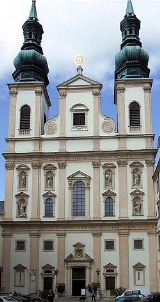
Jesuitenkirche, Vienna
Encyclopedia
The Jesuit Church also known as the University Church is a two-floor, double-tower church in Vienna
, Austria
, influenced by early Baroque
principles but remodeled by Andrea Pozzo
in 1703-1705. The Church is located on Dr. Ignaz Seipel-Platz, immediately adjacent to the old University of Vienna
buildings.
.
In 1703, Brother Andrea Pozzo
, s.j. an architect, painter and sculptor and a master in the quadratura, was invited by the emperor Leopold I to redecorate the church. He added twin towers and reworked the facade in an early Baroque
style with narrow horizontal and vertical sections. The design of the windows, narrow niches (with statues) and the small central part of the façade deviate from the Baroque style of the towers. The church was then rededicated to the Assumption of Mary
.
in 1703, the remarkable trompe l'oeil
dome, painted on a flat part of the ceiling, is a real masterpiece.
Immediately adjacent is the Aula (great hall) of the Vienna's university, where Beethoven
's Seventh Symphony had its premiere.
Vienna
Vienna is the capital and largest city of the Republic of Austria and one of the nine states of Austria. Vienna is Austria's primary city, with a population of about 1.723 million , and is by far the largest city in Austria, as well as its cultural, economic, and political centre...
, Austria
Austria
Austria , officially the Republic of Austria , is a landlocked country of roughly 8.4 million people in Central Europe. It is bordered by the Czech Republic and Germany to the north, Slovakia and Hungary to the east, Slovenia and Italy to the south, and Switzerland and Liechtenstein to the...
, influenced by early Baroque
Baroque
The Baroque is a period and the style that used exaggerated motion and clear, easily interpreted detail to produce drama, tension, exuberance, and grandeur in sculpture, painting, literature, dance, and music...
principles but remodeled by Andrea Pozzo
Andrea Pozzo
Andrea Pozzo was an Italian Jesuit Brother, Baroque painter and architect, decorator, stage designer, and art theoretician. He was best known for his grandiose frescoes using illusionistic technique called quadratura, in which architecture and fancy are intermixed...
in 1703-1705. The Church is located on Dr. Ignaz Seipel-Platz, immediately adjacent to the old University of Vienna
University of Vienna
The University of Vienna is a public university located in Vienna, Austria. It was founded by Duke Rudolph IV in 1365 and is the oldest university in the German-speaking world...
buildings.
History
The Jesuit Church was built between 1623 and 1627 on the site of an earlier chapel, at the time when the Jesuits merged their own college with the University of Vienna's philosophy and theology faculty. The Emperor broke ground for both college and church, with the church itself dedicated to Saints Ignatius Loyola and Francis XavierFrancis Xavier
Francis Xavier, born Francisco de Jasso y Azpilicueta was a pioneering Roman Catholic missionary born in the Kingdom of Navarre and co-founder of the Society of Jesus. He was a student of Saint Ignatius of Loyola and one of the first seven Jesuits, dedicated at Montmartre in 1534...
.
In 1703, Brother Andrea Pozzo
Andrea Pozzo
Andrea Pozzo was an Italian Jesuit Brother, Baroque painter and architect, decorator, stage designer, and art theoretician. He was best known for his grandiose frescoes using illusionistic technique called quadratura, in which architecture and fancy are intermixed...
, s.j. an architect, painter and sculptor and a master in the quadratura, was invited by the emperor Leopold I to redecorate the church. He added twin towers and reworked the facade in an early Baroque
Baroque
The Baroque is a period and the style that used exaggerated motion and clear, easily interpreted detail to produce drama, tension, exuberance, and grandeur in sculpture, painting, literature, dance, and music...
style with narrow horizontal and vertical sections. The design of the windows, narrow niches (with statues) and the small central part of the façade deviate from the Baroque style of the towers. The church was then rededicated to the Assumption of Mary
Assumption of Mary
According to the belief of Christians of the Roman Catholic Church, Eastern Orthodoxy, Oriental Orthodoxy, and parts of the Anglican Communion and Continuing Anglicanism, the Assumption of Mary was the bodily taking up of the Virgin Mary into Heaven at the end of her life...
.
Interior
Despite its relatively austere exterior, the interior is remarkably opulent with ersatz marble pillars, gilding and a number of allegorical ceiling frescoes. The semicircular vault ceiling was divided in four bays with paintings in perspective, using illusionary techniques. Executed by Andrea PozzoAndrea Pozzo
Andrea Pozzo was an Italian Jesuit Brother, Baroque painter and architect, decorator, stage designer, and art theoretician. He was best known for his grandiose frescoes using illusionistic technique called quadratura, in which architecture and fancy are intermixed...
in 1703, the remarkable trompe l'oeil
Trompe l'oeil
Trompe-l'œil, which can also be spelled without the hyphen in English as trompe l'oeil, is an art technique involving extremely realistic imagery in order to create the optical illusion that the depicted objects appear in three dimensions.-History in painting:Although the phrase has its origin in...
dome, painted on a flat part of the ceiling, is a real masterpiece.
Immediately adjacent is the Aula (great hall) of the Vienna's university, where Beethoven
Ludwig van Beethoven
Ludwig van Beethoven was a German composer and pianist. A crucial figure in the transition between the Classical and Romantic eras in Western art music, he remains one of the most famous and influential composers of all time.Born in Bonn, then the capital of the Electorate of Cologne and part of...
's Seventh Symphony had its premiere.

